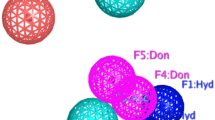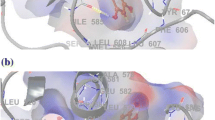Abstract
The Signal Transducer and Activator of Transcription 3 (STAT3) protein is activated consistently in the tumor cells and thus studied as a potent target for cancer prevention. The TYR705-phosphorylated (pTyr) STAT3 forms a homo-dimer by binding to its recognition site in the Src Homology 2 (SH2) domain of another STAT3 monomer, causing cellular survival, proliferation, inflammation, and tumor invasion. Many inhibitors of STAT3-SH2 have recently been identified using both computational and experimental approaches. In this study, we used molecular docking, Absorption, Distribution, Metabolism, and Excretion/Toxicological (ADME/tox) and molecular dynamics modeling to examine binding affinities and specificities of 191 inhibitor drugs from the SELLECKCHEM database. The binding free energies of the inhibitors were calculated by Induced Fit Docking (IFD) prime energy. The binding hotspots of STAT3-SH2 were evaluated via binding energy decomposition and hydrogen bond distribution analysis, and the inhibitor compound's stability was assessed through MD simulation. (−)-Epigallocatechin gallate, Kaempferol-3-O-rutinoside, Picroside I, Saikosaponin D, and Ginsenoside Rk1 were found to be the top hit inhibitor compounds. They exhibited an exceptional docking score, a low binding free energy, interacted with the key amino acid residue, and showed significant ADME/tox moderation. These compounds were further proved to be favorable by their stability in an MD simulation run for 100 ns using GROMACS software. The inhibitors (−)-Epigallocatechin gallate, Kaempferol-3-O-rutinoside, and Saikosaponin D show improved stability in molecular dynamic modeling and are expected to have a significant STAT3-SH2 inhibitory effect against cancer.
Graphical abstract






Similar content being viewed by others
References
Sehgal PB (2008) Paradigm shifts in the cell biology of STAT signaling. Semin Cell Dev Biol 19:329–340. https://doi.org/10.1016/j.semcdb.2008.07.003
Lim CP, Cao X (2006) Structure, function, and regulation of STAT proteins. Mol Biosyst 2:536. https://doi.org/10.1039/b606246f
Quesnelle KM, Boehm AL, Grandis JR (2007) STAT-mediated EGFR signaling in cancer. J Cell Biochem 102:311–319. https://doi.org/10.1002/jcb.21475
Decker T, Kovarik P (2000) Serine phosphorylation of STATs. Oncogene 19:2628–2637. https://doi.org/10.1038/sj.onc.1203481
Murray PJ (2007) The JAK-STAT signaling pathway: input and output integration. J Immunol 178:2623–2629. https://doi.org/10.4049/jimmunol.178.5.2623
Jing N, Tweardy DJ (2005) Targeting Stat3 in cancer therapy. Anticancer Drugs 16:601–607. https://doi.org/10.1097/00001813-200507000-00002
Weidler M, Rether J, Anke T, Erkel G (2000) Inhibition of Interleukin-6 signaling and Stat3 activation by a new class of bioactive cyclopentenone derivatives. Biochem Biophys Res Commun 276:447–453. https://doi.org/10.1006/bbrc.2000.3499
Schust J, Sperl B, Hollis A et al (2006) Stattic: a small-molecule inhibitor of STAT3 activation and dimerization. Chem Biol 13:1235–1242. https://doi.org/10.1016/j.chembiol.2006.09.018
Giraud S, Hurlstone A, Avril S, Coqueret O (2004) Implication of BRG1 and cdk9 in the STAT3-mediated activation of the p21waf1 gene. Oncogene 23:7391–7398. https://doi.org/10.1038/sj.onc.1207972
Giraud S, Bienvenu F, Avril S et al (2002) Functional interaction of STAT3 transcription factor with the coactivator NcoA/SRC1a. J Biol Chem 277:8004–8011. https://doi.org/10.1074/jbc.M111486200
Lee H, Deng J, Kujawski M et al (2010) STAT3-induced S1PR1 expression is crucial for persistent STAT3 activation in tumors. Nat Med 16:1421–1428. https://doi.org/10.1038/nm.2250
Pensa S, Regis G, Boselli D, Novelli F, Poli V (2009) STAT1 and STAT3 in tumorigenesis: two sides of the same coin? In: JAK-STAT pathway in disease, 1st edn. CRC Press, Boca Raton, pp 100–121
Wong ALA, Hirpara JL, Pervaiz S et al (2017) Do STAT3 inhibitors have potential in the future for cancer therapy? Expert Opin Investig Drugs 26:883–887. https://doi.org/10.1080/13543784.2017.1351941
Yue P, Turkson J (2009) Targeting STAT3 in cancer: how successful are we? Expert Opin Investig Drugs 18:45–56. https://doi.org/10.1517/13543780802565791
Turkson J, Ryan D, Kim JS et al (2001) Phosphotyrosyl peptides block Stat3-mediated DNA binding activity, gene regulation, and cell transformation. J Biol Chem 276:45443–45455. https://doi.org/10.1074/jbc.M107527200
Jing N, Zhu Q, Yuan P et al (2006) Targeting signal transducer and activator of transcription 3 with G-quartet oligonucleotides: a potential novel therapy for head and neck cancer. Mol Cancer Ther 5:279–286. https://doi.org/10.1158/1535-7163.MCT-05-0302
Chiba T (2016) Cronicon CANCER Opinion STAT3 inhibitors for cancer therapy—the rationale and remained problems. EC Cancer 1(S1):S1–S8
Turkson J, Zhang S, Mora LB et al (2005) A novel platinum compound inhibits constitutive Stat3 signaling and induces cell cycle arrest and apoptosis of malignant cells. J Biol Chem 280:32979–32988. https://doi.org/10.1074/jbc.M502694200
Siddiquee K, Zhang S, Guida WC et al (2007) Selective chemical probe inhibitor of Stat3, identified through structure-based virtual screening, induces antitumor activity. Proc Natl Acad Sci USA 104:7391–7396. https://doi.org/10.1073/pnas.0609757104
Lee H-M, Chan DS-H, Yang F et al (2010) Identification of natural product Fonsecin B as a stabilizing ligand of c-myc G-quadruplex DNA by high-throughput virtual screening. Chem Commun 46:4680. https://doi.org/10.1039/b926359d
Chan DS-H, Lee H-M, Yang F et al (2010) Structure-based discovery of natural-product-like TNF-α inhibitors. Angew Chem Int Ed 49:2860–2864. https://doi.org/10.1002/anie.200907360
Leung C-H, Chan DS-H, Yang H et al (2011) A natural product-like inhibitor of NEDD8-activating enzyme. Chem Commun 47:2511. https://doi.org/10.1039/c0cc04927a
Zhong H-J, Pui-Yan Ma V, Cheng Z et al (2012) Discovery of a natural product inhibitor targeting protein neddylation by structure-based virtual screening. Biochimie 94:2457–2460. https://doi.org/10.1016/j.biochi.2012.06.004
Ma D-L, Chan DS-H, Leung C-H (2013) Drug repositioning by structure-based virtual screening. Chem Soc Rev 42:2130. https://doi.org/10.1039/c2cs35357a
Miklossy G, Hilliard TS, Turkson J (2013) Therapeutic modulators of STAT signalling for human diseases. Nat Rev Drug Discov 12:611–629. https://doi.org/10.1038/nrd4088
Iwaloye O, Elekofehinti OO, Momoh AI et al (2020) In silico molecular studies of natural compounds as possible anti-Alzheimer’s agents: ligand-based design. Netw Model Anal Health Inform Bioinform 9:54. https://doi.org/10.1007/s13721-020-00262-7
Iwaloye O, Elekofehinti OO, Oluwarotimi EA et al (2020) Insight into glycogen synthase kinase-3β inhibitory activity of phyto-constituents from Melissa officinalis: in silico studies. In Silico Pharmacol 8:2. https://doi.org/10.1007/s40203-020-00054-x
Schrödinger (2018) LigPrep. Schrödinger, LLC, New York
Harder E, Damm W, Maple J et al (2016) OPLS3: a force field providing broad coverage of drug-like small molecules and proteins. J Chem Theory Comput 12:281–296. https://doi.org/10.1021/acs.jctc.5b00864
Sherman W, Beard HS, Farid R (2006) Use of an induced fit receptor structure in virtual screening. Chem Biol Drug Des 67:83–84. https://doi.org/10.1111/j.1747-0285.2005.00327.x
Durán-Iturbide NA, Díaz-Eufracio BI, Medina-Franco JL (2020) In silico ADME/Tox profiling of natural products: a focus on BIOFACQUIM. ACS Omega 5:16076–16084. https://doi.org/10.1021/acsomega.0c01581
Daina A, Michielin O, Zoete V (2017) SwissADME: a free web tool to evaluate pharmacokinetics, drug-likeness and medicinal chemistry friendliness of small molecules. Sci Rep 7:42717. https://doi.org/10.1038/srep42717
Rubin Grandis J, Zeng Q, Drenning SD (2000) Epidermal growth factor receptor-mediated Stat3 signaling blocks apoptosis in head and neck cancer. Laryngoscope 110:868–874. https://doi.org/10.1097/00005537-200005000-00016
Nepomuceno RR, Snow AL, Robert Beatty P et al (2002) Constitutive activation of Jak/STAT proteins in Epstein-Barr virus-infected B-cell lines from patients with posttransplant lymphoproliferative disorder1. Transplantation 74:396–402. https://doi.org/10.1097/00007890-200208150-00017
Samaan A, Mahana W (2007) Constitutive and induced activation of JAK/Stat pathway in leukemogenic and asymptomatic human T-cell lymphotropic virus type 1 (HTLV-1) transformed rabbit cell lines. Immunol Lett 109:113–119. https://doi.org/10.1016/j.imlet.2007.01.008
Báez-Santos YM, Mielech AM, Deng X et al (2014) Catalytic function and substrate specificity of the papain-like protease domain of nsp3 from the Middle East Respiratory Syndrome Coronavirus. J Virol 88:12511–12527. https://doi.org/10.1128/JVI.01294-14
Maffucci I, Hu X, Fumagalli V, Contini A (2018) An efficient implementation of the Nwat-MMGBSA method to rescore docking results in medium-throughput virtual screenings. Front Chem. https://doi.org/10.3389/fchem.2018.00043
Mishra S, Dahima R (2019) In vitro ADME studies of TUG-891, a GPR-120 inhibitor using SwissADME predictor. J Drug Deliv Ther 9:366–369. https://doi.org/10.22270/JDDT.V9I2-S.2710
Lipinski CA, Lombardo F, Dominy BW, Feeney PJ (1997) Experimental and computational approaches to estimate solubility and permeability in drug discovery and development settings. Adv Drug Deliv Rev 23:3–25. https://doi.org/10.1016/S0169-409X(96)00423-1
Baell J, Congreve M, Leeson P, Abad-Zapatero C (2013) Ask the Experts: past, present and future of the rule of five. Future Med Chem 5:745–752. https://doi.org/10.4155/fmc.13.61
Acknowledgements
This work was supported by MHRD-Rashtriya Uchchatar Shiksha Abhiyan (RUSA) 2.0-Bharathiar Cancer and Theragnostic Research Centre (BCTRC), Bharathiar University, Coimbatore, India (BU/RUSA2.0/BCTRC/2020/BCTRC-CT06). The authors also thank B. Satheeswaran, Ph.D. Research Scholar, Bharathiar University for his valuable inputs.
Author information
Authors and Affiliations
Contributions
EP and SM conceived the project; SM wrote the entire manuscript. SM, AB, VH and EP performed the experiment.
Corresponding author
Ethics declarations
Conflict of interest
The authors declare that they have no known competing financial interests or personal relationships that could have appeared to influence the work reported in this paper.
Additional information
Publisher's Note
Springer Nature remains neutral with regard to jurisdictional claims in published maps and institutional affiliations.
Rights and permissions
About this article
Cite this article
Manoharan, S., Balakrishnan, A., Hemamalini, V. et al. Screening of potent STAT3-SH2 domain inhibitors from JAK/STAT compound library through molecular dynamics simulation. Mol Divers 27, 1297–1308 (2023). https://doi.org/10.1007/s11030-022-10490-w
Received:
Accepted:
Published:
Issue Date:
DOI: https://doi.org/10.1007/s11030-022-10490-w




